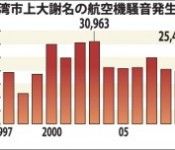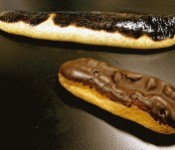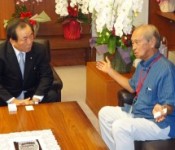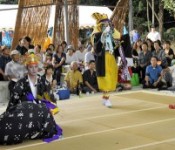Top News

September 13, 2011 Ryukyu Shimpo
On August 15 in the old lunar calendar or September 12 in the modern calendar, harvest festivals to pray for a good year were held throughout the prefecture. In the Itoman district of Itoman City, Itoman Ozunahiki, one of the three grand tugs-of-war in the prefecture, in which the participants prayed for a good harvest was held in style.
From the morning, National Highway No. 331, where the tug-of-war was held, was closed to traffic. According to an announcement by the organizer, a total of about 30000 people participated in the event.
The tug-of-war began at 6.00pm, and after the 30-minute time limit, the Northern team was the winner, pulling the rope two meters and sixty centimeters in their direction. The North has now recorded 33 wins, 28 losses and four draws since 1947.
(English Translation by T&CT, Mark Ealey)
Go To Japanese

Go To Video

September 20, 2011
“The Okinawa Question: Regional Security, the U.S.-Japan Alliance and Futenma (hosted by the Okinawa Question U.S.-Japan Action Committee)”, an international symposium in which key figures from the United States and Japan discuss the issue of the U.S. military bases in Okinawa and U.S.-Japan security policy, was held at George Washington University in Washington DC in the morning of September 19.
Okinawa Governor Hirokazu Nakaima delivered a lecture in which he called for the review of the agreement between the United States and Japan that has the replacement facilities for Futenma Air Station down to be constructed at Henoko in Nago City. This is the first time that Nakaima has gone to the United States to demand the relocation of Futenma Air Station out of the prefecture.
With regard to the Okinawan people’s strong desire to move the base outside of the prefecture, Nakaima stated, “Relocating Futenma Air Station to another prefecture or city within Japan is the most logical thing to do and the best way to quickly resolve the matter. The current plan to move the facilities to Henoko should be revised.”
The advent of a new administration in September 2009 saw the Japanese government consider relocating the Futenma Air Station out of the prefecture or the country altogether, but it ended up returning to the existing plan to relocate it within the prefecture, without agreement from the people of Okinawa, and reached an agreement on this with the U.S. government on May 2010.
Nakaima said, “The agreement between the U.S. and Japanese governments has given momentum to Okinawan people’s demands for the relocation of the air station out of the prefecture.”
With that in mind, Nakaima went on to warn that the U.S. and Japanese governments pushing through the relocation to Henoko could trigger fierce anti-base movements across the prefecture, a development that could impact negatively upon the Japan-U.S. security alliance.
With regard to the Japanese government’s alluding towards the continuation of the operation of Futenma Air Station with no progress on relocation of Futenma relocation, Nakaima pointed out the dangerous nature of an air station placed in such a densely populated area where there are schools and residential areas, saying, “It is just not possible to continue to operate the base in its current manner.” Nakaima stated that the early relocation of Futenma Air Station and the swift return of military-occupied land is absolutely necessary.
“The Okinawa Question” is a meeting of experts on diplomatic issues between Japan and the United States including security issues.
Akikazu Hashimoto, affiliate professor of J. F. Oberlin University, was the head of the Japanese contingent, and Mike Mochizuki, professor of George Washington University, headed the American contingent.
(English Translation by T&CT, Mark Ealey)
Go To Japanese

September 12, 2011 Ryukyu Shimpo
On September 11, to mark six months having passed since the Great East Japan Earthquake and the subsequent Fukushima Daiichi nuclear disaster, a protest march against nuclear power plants entitled “9.11 Anger in Fukushima March,” was held in an open area near the Fukushima Prefectural Office.
According to the protest organizers, 200 people including local citizens marched, chanting, “Decommission the nuclear power plants!” “Give us Fukushima back!” and “Protect the lives and future of our children!”
Participants in the protest march pointed out that 10 of the 54 nuclear power plants in Japan are located in Fukushima Prefecture, saying that, “Just as the Japanese government locates 75% of the United States military forces in Japan in Okinawa, the Government forces less wealthy prefectures to accept military bases and nuclear power plants that could cause trouble for the local people. We don’t want military bases or nuclear power plants. They put our lives in danger.” The protesters linked the issue of the presence of U.S. military bases in Okinawa with that of the nuclear power plants in Fukushima.
People who spoke at the rally said things such as, “The people of Fukushima Prefecture may be meek and mild, but the time has come to speak up and act.” “Health is more important than money” and “Everyone in the prefecture is angry. Although many people hesitate to speak up, we cannot trust a government that doesn’t give priority to the lives of children, to the lives of our children.”
With regard to swiftly decommissioning the nuclear power plants, the protesters shouted, “Ganbarou!” (trans: We’ll give it our best shot!) three times.
When interviewed by the Ryukyu Shimpo, the head of Fukushima Association to Protect Children, Sachiko Sato, said, “This is a fight between those who value money and the rest of us who value people’s lives. It is not that military that protects people’s lives. The nuclear accident has destroyed the natural environment of Fukushima. We don’t need U.S. military bases that could destroy the beautiful sea around Okinawa.”
Seiichi Nakate, the head of the Fukushima Network for Saving Children from Radiation, said, “I would like to express our gratitude to the people of Okinawa for supporting us to the extent that they have. I sense that we need to become linked to the people of Okinawa at grass-roots level and fight for our future.”
Fifty-one year-old Mieko Touyama, a member of the network, said, “Both Okinawa and Fukushima face very similar issues. The nuclear accident has made us keenly aware of the pain the people of Okinawa suffer. [With regard to the issues of the U.S. military bases in Okinawa], I feel sorry about the situation that they are in.”
After the rally, the participants marched through the downtown area chanting slogans – “Give us back our sky and sea!” or “Give us back our arable land!” and formed a human chain in front of the local government hall, where the Fukushima chapter of the Reconstruction Headquarters in response to the Great East Japan Earthquake is located.
(English Translation by T&CT, Mark Ealey)
Go To Japanese
September 11, 2011 Kenyu Uchima of Ryukyu Shimpo
Since the terrorist attacks on September 11, 2001, in the waters provided for military use near White Beach in the Katsuren district, Uruma City, United States warships have pointed their deck guns toward local fishing vessels passing close by. The fishermen have been terrified to have U.S. Navy warships taking aim at them. The Katsuren Fishery Association, headed by Hiroyuki Akamine, recently requested that the Okinawa Defense Bureau bring an end to this intimidation by U.S. warships. On September 7, the Okinawa Defense Bureau reported to the Association that they had conveyed the request to the U.S. military.
According to the Association, following the 2001 terrorist attacks the U.S. military enhanced its security in the water areas and around White Beach. Ten years have passed since the 9/11 attacks, but the shadow cast by the activities of the U.S. military in their many facilities and in the large area they use in Okinawa is as pronounced as ever.
Around White Beach, there is a water area available for the U.S. military whenever they need it. According to the Association, local fishermen have to go through that area designated for military use to get out to their fishing grounds. Since the terrorist attacks a decade ago, whenever nuclear submarines and other warships call at the White Beach, U.S. patrol boats have menaced fishing boats, pointing their deck guns at them as they cross the stretch of water in question. In response to the request from the fishermen lodged in the middle of August, in September 7, a staff member of the Okinawa Defense Bureau visited the office of the Association and explained developments.
Shortly after the September 11 terrorist attacks, the U.S. government requested that the Japanese government take precautionary measures when nuclear submarines call in to port at White Beach, because such vessels “may be a terrorist target.”
On the request of the Foreign Ministry, in the past the Okinawa Prefectural Government gave the media information on visits to White Beach by U.S. nuclear submarines. However, in order to strengthen the security around White Beach, since the September 11 attacks the Foreign Ministry has withheld such information.
(English Translation by T&CT, Mark Ealey)
Go To Japanese

September 10, 2011 Ryukyu Shimpo
Ten years have passed since the September 11 2001 terrorist attacks on the United States. Taking the lead in the war against the terrorism, the United States plunged itself into war in Iraq and Afghanistan, sending units to the battle areas from their bases in Okinawa. During this time, in preparation for combat in the Middle East, the Marine Corps has intensified its training of its personnel in Okinawa, and this has led to accidents and incidents involving the military, including when a helicopter due to be deployed in Iraq crashed onto Okinawa International University. Okinawa has clearly been affected by the war in the Middle East. In this article, we take a look at what has been changed by 9/11 on this military island and what the prospects are for the future.

Movements in Okinawa and Japan since the September 11 terrorist attacks on the United States. (click to enlarge)
In the period since the terrorist attacks on the United States, the 31st Marine Expeditionary Unit, including the helicopter squadron of the U.S. Marine Corps Air Station Futenma, has been incorporated in the mop-up operations in the Middle East under the banner of “the war on terrorism.” In August 2004, a helicopter that had landed at Futenma Air Station before being deployed as part of “Operation Iraqi Freedom” crashed onto Okinawa International University. The Government of Japan has effectively given silent approval of the U.S. military presence in Okinawa without seeking to verify the nature of any overseas deployment and now they have approved the deployment to Futenma next fall of MV-22 Osprey vertical take-off aircraft, with the risks it brings. Despite the difficulties involved or the risks to the local residents, the nature of the air station has not changed and the United States still uses it however it sees fit.
Since 9/11, the number of flights from other bases to Futenma Air Station has increased, and as a result, the level of noise pollution in the residential area around the air station has become worse. In 2002 and 2003, in the Ue Ojana district, Ginowan City, aviation noise lasting more than five seconds at least 70db was recorded 30000 times. This figure is more than 1.5 times the number for an average year in the same area. The increased level of training has also led to more accidents and emergency landings of aircraft, with ten cases officially announced for the period from 2001 to 2003.
The number of airplanes assigned to Futenma has gone down from 71 to 52 since the outbreak of war in Iraq. The number of CH-46 helicopters is unchanged, and the number of CH-53E, AH-1 and UH-1 helicopters has been drastically reduced, but the issue of noise pollution is yet to improve with over 25000 occurrences of aviation noise recorded at Ue Ojana last year. The Base Affairs Policy Division of Ginowan City speculates that repeated takeoffs and landings of a small number of aircraft is the cause of the noise pollution, despite the reduced number of aircraft. A group of five helicopters were confirmed as having flown over the residential area to the north of the runway in May of this year.
Shigeo Yamauchi, the head of the Base Affairs Policy Division of Ginowan City, said, “We residents have been viewed as an unimportant part of the equation by the United States and those running its military operations. Japanese government officials have not complained to them, and the U.S. military interprets this as meaning that they are allowed to do anything they like.” He also stated, “The U.S. military has failed to observe standard operating procedure or the accepted rules, such as noise control measures, environmental principles and traffic patterns for their flights. The Japanese government should ascertain the details of the movement of U.S. forces and point out the problems to them.”
(English Translation by T&CT, Mark Ealey)
Go To Japanese

September 11, 2011 Ryukyu Shimpo
On a moonlit night on September 10, the 18th Shurijo Castle Park Mid-Autumn Celebration (organized by the Okinawa Commemorative National Government Park) was held at Shurijo Castle Park in Naha City.
On the special stage lit up in the Una Forecourt in front of the Seiden State Hall, glamorous Ryukyuan dance and music said to be the same as that used to entertain envoys from China during the era of the Ryukyu Dynasty was performed. Ryukyuan dance songs such as Kajadefu and Nubui Kuduchi were performed by Miyagi Honryu Otori No Kai on the opening day of the celebration. Music and dance performances by Kishun Nishie, who was designated as a Living National Treasure earlier this year, as well as Tokutaro Shiroma and Noho Miyagi, entertained the many tourists who came to watch.
On September 11, the Kumiodori play, Nidoutichiuchi, was performed by Kinjoseiichi Kumiodori Kai and a contest was held to select the king and queen who will participate in the events of Shurijo Castle Park this year.
(English Translation by T&CT, Mark Ealey)
Go To Japanese

Go To Video

September 10, 2011 Ryukyu Shimpo
Daisuke Ueno, a fellow of the Department of Science of University of the Ryukyu who specializes in Aquarium parasitology, and his research group, recently found a sea cucumber that resembles the western confectionery éclair at several locations in the waters around Okinawa Island. It is the first time that this type of sea cucumber has been discovered in the northern hemisphere. Ueno and his group named it (in Japanese) the “Eclair sea cucumber” and reported it in the Journal of the Okinawa Biological Society published in August. “Its taste has none of the sweetness of an éclair. It is more a mixture of a bitter taste and astringency,” said Ueno after sampling one.

Daisuke Ueno
Eclair sea cucumbers have been found in the waters off Maeda Cape, Zanpa Cape, Manzamo and Sesokojima where they enjoy living in sand at a depth of more than 35 meters on the outer edge of reefs and in environments covered in algae. They have relatively large bodies, reaching a length of 40-50 centimeters, with black spots on a yellow back and a black vertical pattern on its belly.
The same type of sea cucumber was announced as a new species collected in 2005 and 2007 in Australia. Ueno found his examples of the species in 2000 when out diving. However, he had not gone as far as identifying it.
He said, “These sea cucumbers usually prefer to live at a depth at which divers cannot stay for a long time, and there are only a few experts in the world capable of classifying sea cucumbers. For these reasons, its discovery and naming took time.” Ueno stated, “Its discovery suggests that we have a favorable environment in which to observe many unknown organisms, at places relatively easily accessed by scuba divers.”
(English Translation by T&CT, Mark Ealey)
Go To Japanese

September 10, 2011 Ryukyu Shimpo
On September 9, Okinawa Prefectural Governor Hirokazu Nakaima visited Foreign Minister Koichiro Genba and Defense Minister Yasuo Ichikawa. On the topic of the Futenma relocation of the United States Marine Corps Air Station, the Governor said, “Seeking a place outside the prefecture will be a quicker solution.” He requested that both ministers review the agreement between the United States and Japan in which the replacement facilities for Futenma Air Station are set to be constructed at Henoko, Nago City. According to the Governor, neither minister has given a specific reply to his request.
With regard to the multiple-entry visa for Chinese tourists and the Sixth Japan-Pacific Islands Forum Summit Meeting to be held in Okinawa, the Foreign Minister indicated his commitment to Okinawa by saying, “I have only just assumed the post, but I have directed Ministry officials to do what we can [for the Okinawa promotion].” The Governor asked the Minister for an explanation of progress made to reduce the burden on Okinawa, such as the revision of the Status of Forces Agreement that governs the legal status of U.S. troops and the return of water areas used for training by the U.S. military. The Foreign Minister went no further than saying, “I will approach these issues with the utmost sincerity.”
At the press conference on the same day, the Foreign Minister said, “I understand the Governor’s standpoint, but I will move forward on the Futenma relocation plan in keeping with the Japan-U.S. agreement,” indicating that he does not intend that the base will be relocated to outside the prefecture. With regard to the request from the Mayor of Ginowan City for evacuation measures for the residents of Ginowan City in which they are allowed to move into the U.S. military facilities in the case of disaster, Genba demonstrated a positive approach, saying, “I will approach this issue with the utmost sincerity.”
After meeting with the Governor, in his press conference Ichikawa said, “I would like to let him know that I will actively work to resolve the pending issue [Futenma relocation issue]”showing his intention to move ahead in keeping with the Japan-U.S. agreement.
(English Translation by T&CT, Mark Ealey)
Go To Japanese
September 10, 2011 Ryukyu Shimpo
At around 11:30am on September 9, workers carrying out a magnetic survey in the grounds of Shuri High School in Mawashi Town of Shuri, Naha City, as part of the process of constructing a new school building found three unexploded shells around 1.5 meters below the surface of the ground. They reported this to the Naha Police Station.
The Ground Self-Defense Force bomb disposal team that answered the request from the fire station quickly recovered two of the shells, but gave up retrieving the third piece of ordnance, a U.S. 50 kilogram bomb.
Disposal of the remaining bomb will be carried out on the site in the days ahead.
On August 24 this year, another U.S. 50 kilogram bomb was also found on this location, about 30 meters away from the latest discovery. That bomb has been kept in a carefully protected situation with the fuse still in place. The latest bomb has a diameter of about 20 centimeters and has an overall length of about 80 centimeters. It also has its fuse still in place. The disposal team has sandbagged the bomb and covered it with liner plates.
The disposal team succeeded in quickly recovering a U.S. 75mm shell, with a diameter of about 7 centimeters and an overall length of about 30 centimeters, and a 105mm shell, which has a diameter of about 10 centimeters and an overall length of about 40 centimeters.
Students and local residents were not evacuated during the emergency bomb disposal work and other subsequent procedures.
Assistant principal of Shuri High School, Tsutomu Maeda, said, “We carried out a magnetic survey here after the unexploded ordnance was found last time, and found the bombs that way. I don’t know if any more will be found in future.”
(English Translation by T&CT, Mark Ealey)
Go To Japanese
September 8, 2011 Ryukyu Shimpo
If all goes smoothly, the Okinawan Prefectural Government (OPG) will open an office in Beijing later this year. OPG hopes that this will contribute to the expansion of sales channels for the products and to attract Chinese tourists to Okinawa. The office will start with a manager from the OPG, and one or two local employees. In September, at the regular meetings of Okinawa Prefectural Assembly, the government will suggest that about 15 million yen be put aside to cover expenses for the Beijing Office. A staff member from the OPG has already visited Beijing to look for an appropriate office building and to coordinate matters with related agencies.
The OPG’s Beijing office will be the fifth set up overseas, following on from offices in Taiwan, Hong Kong, Shanghai and the Korea office for Okinawa Convention & Visitors Bureau (OCVB). The opening date has not been decided upon, because its takes time to get through the complicated approval process in Beijing. In the case of the Shanghai office set up in 2005, it took six months from the start of this process until it opened. Circumstances on the Chinese side mean that the OPG Beijing Office will start as the office for Okinawa Industrial Promotion Public Corporation.
The OPG had been considering setting up an office in Beijing and took the plunge and started planning when some favorable developments occurred, such as multiple-entry visas for Chinese tourists and an airline commencing a service between Beijing and Naha. The OPG hopes to help Okinawan companies to expand their business in the Chinese market.
With regard to the date of the opening of the office, a spokesperson for the Industrial Policy Division of the OPG said, “We are concerned that the procedures will take a long time because the relevant law is has been revised in China this year, but we want to open the office as early as possible during the year. The first thing that we will do is approach airline companies in Beijing in an attempt to attract Chinese tourists to Okinawa.”
(English Translation by T&CT, Mark Ealey)
Go To Japanese

September 6, 2011 Ryukyu Shimpo
The August Dance Festival, which is designated as one of Japan’s significant intangible folk cultural assets, was held at Ntabaru Uganju, a sanctuary area in Nakasuji, Tarama Village from September 5 to 7 (from 8th to 10th day of the 8th month of the traditional calendar).
Traditional performing arts such as Kumiodori and Kyogen were performed at the Festival, which attracted many tourists. All the residents of Tarama Island dedicated themselves to making this important event a success.
As part of the Ryukyuan narrative dance Kumiodori, plays such as Chushin Nakasone Toyumyagumi and Chukofujin were performed.
Teacher of Tarama Elementary School, 35 year-old Kazuto Kawamitsu, who participated in the event for the second year in a row and performed his play in Kyogen, a Japanese comic theater style, said, “It was quite difficult to perform because the play requires you to depict both seriousness and comedy, but I think that I managed it. It was a really valuable experience for me.”
The Okinawan capital of Shuri introduced Kumiodori to Tarama Village in the middle of the Meiji period. To begin with, the performers of Kumiodori in the Village were people who belonged to the warrior class, but commoners gradually joined in, and now there is no distinction of social classes for Kumiodori performers in the village.
Kumiodori in Tarama Village has some unique aspects, one of which is that when the performers walk, they show the bottoms of their feet.
On September 6, the Festival was held at Pitomata Uganju in Shiokawa in Tarama Village. On the final day of the Festival, September 7, the participants performed plays under the title of “parting” in both Nakasuji and Shiokawa.
(English Translation by T&CT, Mark Ealey)
Go To Japanese












 Webcam(Kokusai Street)
Webcam(Kokusai Street)


